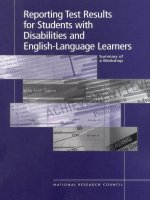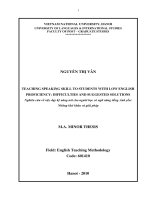Helping Students with Modals
Bạn đang xem bản rút gọn của tài liệu. Xem và tải ngay bản đầy đủ của tài liệu tại đây (76.1 KB, 3 trang )
Helping Students with Modals
Michael Thompson
When asking students to learn modal auxiliaries and modal equivalents, ESL/EFL teachers
are asking them to learn how to form these modals correctly, recognize categories of
modality, and choose the appropriate modal for expressing modality. These activities are
desgined to help students learn to master the intricacies of English modals. These activities
are desgined to help students learn to master the intricacies of English modals in three
areas: forming modals, recognizing categories of modality, and using modals to express
modality.
Introduction
We ask our students to learn a lot when we ask them to learn modal auxiliaries and modal
equivalents. There are, first of all, the myriad forms taken by the various modals, some of
which have subtle distinctions. Students need to become comfortable with the fact that can
does not take the auxiliary do in a question (no *do you can speak Spanish?) while have to
does (no *Have you to go to Rome?).
More important is that modals are distinguished from other auxiliaries by the fact that they
have meaning. Students, therefore, need to become comfortable not only with the
grammatical properties of modals, but their semantic properties as well. This is
complicated by the fact that there is more than one category of meaning and the same
modals are often used in more than one.
The first category -- called "deontic modality" -- is used to perform speech acts, such as
offering, requesting, granting permission, commanding, etc.. When I tell my son, "You
must be home by 10 o'clock." I am using deontic modality.
The second category -- epistemic modality -- is used to express the speaker's opinion about
the truth of a proposition. When I say, "You must be Rachel Thorne. You look just like
your sister." I am saying that I am certain that the proposition "you are Rachel Thorne" is
true.
A third category of modality is a bit more elusive. One characteristic of both deontic and
epistemic modality is that the modals are connected with the speaker, not just the subject.
With deontic modality, the modal refers to what the speaker is doing with the sentence.
With epistemic modality, the modal refers to how the speaker sees the proposition. The
third category -- sometimes called "dynamic modality" -- is more subject-oriented. "Rosa
can run a mile in under five minutes." refers to one of Rosa's abilities; it does not give
information about the speaker.
A third hurdle for English-language students is that not all languages prefer to use modals
to express these ideas. Modality is often expressed with other forms of speech. "You are
obliged to be home by 10 o'clock", "I am certain that you are Rachel Thorne. You look just
like your sister.", and "Rosa is capable of running a mile in under five minutes." all express
the ideas explored, and if they sound stilted it is only because English has a preference for
modal verbs rather than modal adjectives.
Re-phrasing
One of the most direct methods for providing experience with modals is to ask to students
to re-phrase sentences. This can be done either as a speaking or writing exercise, and offers
an advantage over more traditional cloze exercises in that the context is not open to
interpretation. Such interpretations of context are common (I think the sentence refers to an
obligation, but the student thinks it refers to a suggestion), and make it difficult to evaluate
whether the student is using the modal correctly (i.e., is he using should because he thinks
that the sentence refers to a suggestion or because he thinks should is used to express
obligation?).
Generally with re-phrasing, students are given a sentence which expresses modality
without using a modal. They are then asked to re-phrase this sentence, using the
appropriate modal. One example would be:
I am reasonably certain that Francesca is home.
Francesca __________________. (should be home)
However, there is no reason the presentation cannot be reversed, with students being asked
to re-phrase a sentence that contains a modal.
A variation which might be helpful for lower-level classes would be to give students a
choice of three possible re-phrases.
I am reasonably certain that Francesca is home.
a. Francesca should be home.
b. Francesca doesn't have to be home.
c. Francesca must be home.
Role Plays
In this activity, students are divided into pairs, and each pair is given a situation.
The situation might be:
"Student A, you want to go to a concert with your friends. Please ask Student B for
permission. Student B, you are worried about Student A going to the concert. Negotiate
with Student A and command him be home at a specific time."
Another situation might be:
"Student A, you are going to a business meeting in Tokyo with Student B. Please discuss
your trip with him and say when you expect the meeting to start and finish, and when you
expect to return home. Student B, discuss the trip with Student A, and say that it is
necessary for you to be back at a certain time because you have another meeting."
The situations chosen should, of course, be meaningful to the students. Modals should be
avoided in the description of the situation, but used during the role play itself. The students
should be given a couple of minutes to prepare the role play, which is then presented in
front of the class. Examples of modals are then taken from the role play, and the students
who did not participate are asked to identify what the modals referred to. (For example,
"Student A said "We have to be back by tomorrow evening." Was she making a
suggestion? Was she talking about being certain that something was true? What do you
think?)
Footnote
modal auxiliaries are those auxiliaries such as can and should that 1) have no non-finite
form; 2) no ?s inflection for the 3rd person singular; 3) cannot be used with other modals in
a sentence; and 4) are inverted for questions. Modal equivalents are auxiliaries such as
have to and used to which function like modals but have different structures. In the interest
of brevity I will use the term "modals" to mean both groups.


![teaching music to students with special needs [electronic resource] a label free approach](https://media.store123doc.com/images/document/14/y/pj/medium_pju1401474515.jpg)






